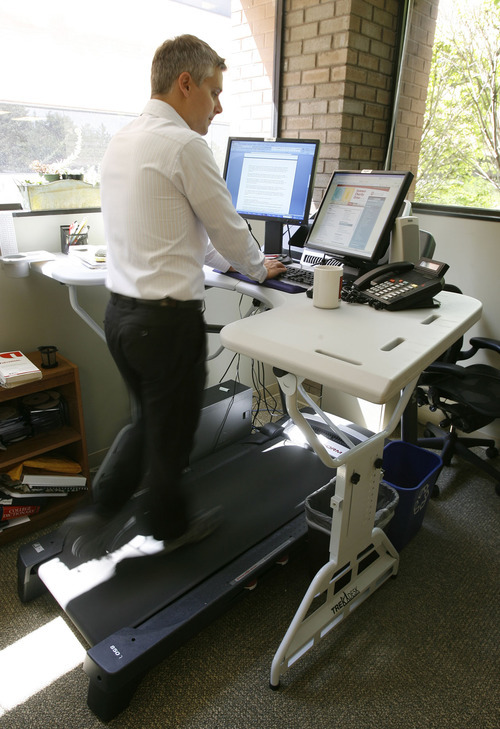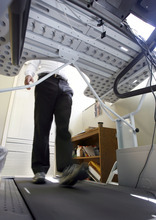This is an archived article that was published on sltrib.com in 2011, and information in the article may be outdated. It is provided only for personal research purposes and may not be reprinted.
It is well understood that aerobic exercise is key to health, but now researchers are looking into whether the good effects of exercise can be undone by muscular inactivity.
In a word, sitting.
Wide-ranging experiments on subjects such as rats, weightless astronauts, Australian television watchers and men who operated London buses have led to a new understanding that inactivity isn't the same as lack of exercise — not at all.
For many of us, no matter how diligent we are about regular, intense aerobic exercise and good nutrition, the benefits of our good habits can be wiped out because we sit so many hours at work, in the car and at home.
Our modern lives have put us at risk for chronic diseases and an early death because, in our computerized workplaces and our TV chairs, we allow our antigravity muscles to go slack.
As University of Tennessee researcher Gregory Heath says, "Essentially, opportunities for physical activity have been systematically engineered out of our daily lives."
We now sit for more hours each day than we sleep. Some studies suggest that sitting more than six hours a day makes a death within 15 years more likely than if we sit just three hours per day — even if we do aerobic exercise.
—
Couch potato science • Researchers are still gathering facts, but circumstantial evidence indicates a possible connection between the obesity epidemic and the personal-computer revolution and the expansion of the desk-job economy in the past 30 years.
That's one reason the Stanford Longevity Center organized a two-day conference last year called The Science of Sedentary Behavior. Among the researchers who attended: Australian scientists who examined the 1999-2000 television-watching habits of 11,000 Australian adults and other studies to come up with what they call the Active Couch Potato phenomenon.
Even in the early 20th century, research pointed to inactivity problems, said Ken Smith, an engineer who serves as the Center on Longevity's director of academic and research support. A study looked at the differences between the physical experiences of conductors and drivers of London buses. One of the metrics for comparison was the men's trouser size.
The Stanford University organization isn't about extending lifespans, but rather about facing up to the problems that have accompanied the gift of longer lives, Smith said.
It used to be that people died of infectious diseases, workplace accidents and poor sanitation. But in the early 20th century, that began to change. By the end of World War II, Americans had become more sedentary, a health risk researchers now believe on par with — and as avoidable as — smoking, poor nutrition and heavy alcohol intake.
If that could be proved, science could back interventions in workplaces that would help reduce chronic illnesses at a time when people are living longer and putting tremendous pressure on our expensive medical system.
"That excited us," Smith said. "If you could actually understand it , it's something you could do something about."
—
Walking at work • A high-school pole-vaulting mishap led to nearly 20 years of back pain for Michael Mozdy, 36, associate director of strategic internal communications for the University of Utah Health Science Center.
Just last year, his doctor diagnosed his fractured vertebra and degenerated spinal discs. After fusion surgery and a solid month of taking pain medications and watching television, Mozdy returned to his desk job, gingerly.
The previous year, he'd been a triathlete. "I knew that sitting wasn't going to help me," he said. "I was gaining weight, definitely losing my cardiovascular shape."
With his office space scheduled for refurbishment, he researched his options for working while standing. Now he walks while working at a TrekDesk, a molded plastic desktop that raises and lowers on metal legs — which spans a small, ordinary treadmill he sets at 1 mph.
Mozdy figures he walks about three hours a day. "Walking is so natural," he said. "You will get lost in your task, but you will have walked a mile." The activity isn't aerobic, but Mozdy does have to focus, balance and engage his postural muscles enough not to fall off.
Mozdy said he's already pain-free and figures that the setup has helped him rehabilitate his back. But he also looks at his treadmill desk as an intervention. He has many years ahead of him as a desk worker.
—
Get off your bum • At Intermountain Healthcare's TOSH — The Orthopedic Specialty Hospital — physiologist James Walker regularly sees the bad results of sitting at desks: circulation problems, loss of bone density, back and neck injuries, bad knees, compressed gluteus muscles and humped shoulder blades.
All because when we sit, our postural muscles go limp. Postural muscles are the ones in our legs, hips, gluteus, back and abdominal core that help us resist gravity and keep us from collapsing into a heap of bones.
Sitting people burn just 1 calorie per minute. And over the hours, our spines are destabilized by slouching and compression.
"Whereas if you're up and moving around, that stimulates the fluid in the discs," said Walker, Intermountain Healthcare's sports science director. "It's just like in the knee. If you don't move your knees, that fluid isn't moving around bathing the structures."
Bulging discs come from sitting. So does lordosis, a skeletal curvature where shoulders slump and your spine arches. "If you're looking at a computer, you jut your jaw out and put a curve in your cervical spine," Walker said. "Your skull is really heavy."
People who sit too much can damage their metabolic health. That's because postural muscles must be engaged to create the cellular-level chemical reactions that convert calories into energy.
"Back a couple of generations, a meat-and-potatoes generation certainly wouldn't conform to our current dietary recommendations," Walker said. "But we weren't fat because we worked."
Sitting on your gluteus muscles all day without moving much literally mashes them, Walker said. Distance runners and athletes who primarily are office workers are finding they can't muster the athletic power they once had because their glutes are dysfunctional.
—
Small steps • More research is needed before scientists can call for health policies that reduce sitting, Smith said.
But in the meantime, people can use common sense to combat inactivity. First, keep up your aerobics. Take the stairs, park farther from your destination, eat standing up at a cafe-style counter. When practical, use a handbasket instead of a shopping cart. Get a desk like Mozdy's. Stand up on the bus or train. Instead of using a chair, sit on an exercise ball at your desk. Just make sure the ball is big enough so your glutes sit slightly higher than your knees, Walker said.
"It makes you sit up and be erect and balanced when you work," he said. "You can slump, but eventually you start rolling."
Walker said physiologists used to believe that it was enough to get up from sitting every 50 minutes, but determined that wasn't often enough. Now, the recommendation is to get up and walk around every 25 minutes. Computers can be set to remind workers to stand.
Workers can also bring back a little old-school communication. "When somebody shoots me an email in the building, I don't just mail back, 'Yes,' " Walker said. "I get up and go to their office and take care of it."
Twitter: @sltrib.henetz —
Inactivity wreaks health havoc
Research has shown connections between too much sitting and dangerous diseases, including:
Coronary heart disease
Breast cancer
Obesity
Colon cancer
Osteoporosis
Depression
Digestive problems
Loss of muscle mass (sarcopenia)
Gallbladder disease
High cholesterol
Sleep apnea
Stroke
Type 2 diabetes







